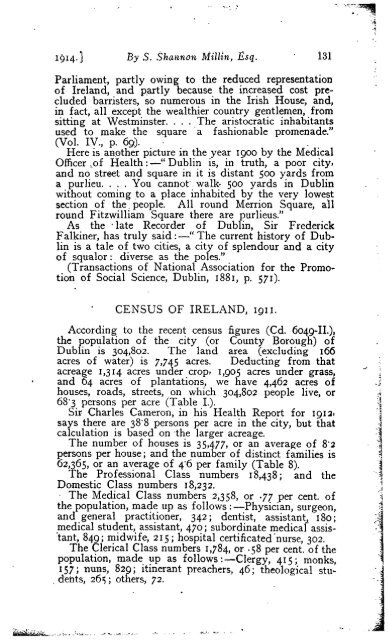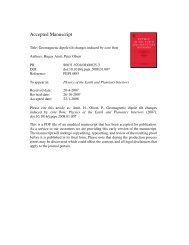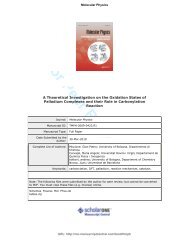Read Friday, 23rd January, 1914. - TARA - Trinity College Dublin
Read Friday, 23rd January, 1914. - TARA - Trinity College Dublin
Read Friday, 23rd January, 1914. - TARA - Trinity College Dublin
Create successful ePaper yourself
Turn your PDF publications into a flip-book with our unique Google optimized e-Paper software.
<strong>1914.</strong>] By S. Shannon Millin, Esq. ' 131<br />
Parliament, partly owing to the reduced representation<br />
of Ireland, and partly because the increased cost precluded<br />
barristers, so numerous in the Irish House, and,<br />
in fact, all except the wealthier country gentlemen, from<br />
sitting at Westminster. . . . The aristocratic inhabitants<br />
used to make the square a fashionable promenade/'<br />
(Vol. IV., p. 69). -<br />
Here is another picture in the year 1900 by the Medical<br />
Officer ,of Health:—"<strong>Dublin</strong> is, in truth, a poor city><br />
and no street and square in it is distant 500 yards from<br />
a purlieu. . . . You cannot walk- 500 yards in <strong>Dublin</strong><br />
without coming to a place inhabited by the very lowest<br />
section of the. people. All round Merrion Square, all<br />
round Fitzwilliam Square there are purlieus."<br />
As the 'late Recorder of <strong>Dublin</strong>, Sir Frederick<br />
Falkiner, has truly said :—" The current history of <strong>Dublin</strong><br />
is a tale of two cities, a city of splendour and a city<br />
of squalor: diverse as the poles."<br />
(Transactions of National Association for the Promotion<br />
of Social Science, <strong>Dublin</strong>, 1881, p. 571).<br />
CENSUS OF IRELAND, 1911.<br />
According to the recent census figures (Cd. 6049-IL),<br />
the population of the city (or County Borough) of<br />
<strong>Dublin</strong> is 304,802. The land area (excluding 166<br />
acres of water) is 7,745 acres. Deducting from that<br />
acreage 1,314 acres under crop* 1,905 acres under grass,<br />
and 64 acres of plantations, we have 4,462 acres of<br />
houses, roads, streets, on which 304,802 people live, or<br />
68*3 persons per acre (Table I.).<br />
Sir Charles Cameron, in his Health Report for 1912*<br />
says there are 38*8 persons per acre in the city, but that<br />
calculation is based on the larger acreage.<br />
The number of houses is 35,477, or an average of 8'2<br />
persons per house; and the number of distinct families is<br />
62,365, or an average of 4*6 per family (Table 8).<br />
The Professional Class numbers 18,438; and the<br />
Domestic Class numbers 18,232.<br />
- The Medical Class numbers 2,358, or *JJ per cent, of<br />
the population, made up as follows : —Physician, surgeon,<br />
and general practitioner, 342; dentist, assistant^ 180;<br />
medical student, assistant, 470; subordinate medical assistant,<br />
849; midwife, 215; hospital certificated'nurse, 302.<br />
The Clerical Class numbers 1,784, or .58 per cent, of the<br />
population, made up as follows:—Clergy, 415; monks,<br />
157; nuns, 829; itinerant preachers, 46; theological stu-<br />
, dents, 265; others, 72.
















